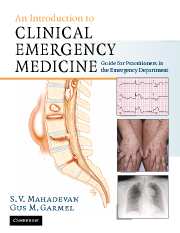Book contents
- Frontmatter
- Contents
- List of contributors
- Foreword
- Acknowledgments
- Dedication
- Section 1 Principles of Emergency Medicine
- Section 2 Primary Complaints
- 9 Abdominal pain
- 10 Abnormal behavior
- 11 Allergic reactions and anaphylactic syndromes
- 12 Altered mental status
- 13 Chest pain
- 14 Constipation
- 15 Crying and irritability
- 16 Diabetes-related emergencies
- 17 Diarrhea
- 18 Dizziness and vertigo
- 19 Ear pain, nosebleed and throat pain (ENT)
- 20 Extremity trauma
- 21 Eye pain, redness and visual loss
- 22 Fever in adults
- 23 Fever in children
- 24 Gastrointestinal bleeding
- 25 Headache
- 26 Hypertensive urgencies and emergencies
- 27 Joint pain
- 28 Low back pain
- 29 Pelvic pain
- 30 Rash
- 31 Scrotal pain
- 32 Seizures
- 33 Shortness of breath in adults
- 34 Shortness of breath in children
- 35 Syncope
- 36 Toxicologic emergencies
- 37 Urinary-related complaints
- 38 Vaginal bleeding
- 39 Vomiting
- 40 Weakness
- Section 3 Unique Issues in Emergency Medicine
- Section 4 Appendices
- Index
25 - Headache
Published online by Cambridge University Press: 27 October 2009
- Frontmatter
- Contents
- List of contributors
- Foreword
- Acknowledgments
- Dedication
- Section 1 Principles of Emergency Medicine
- Section 2 Primary Complaints
- 9 Abdominal pain
- 10 Abnormal behavior
- 11 Allergic reactions and anaphylactic syndromes
- 12 Altered mental status
- 13 Chest pain
- 14 Constipation
- 15 Crying and irritability
- 16 Diabetes-related emergencies
- 17 Diarrhea
- 18 Dizziness and vertigo
- 19 Ear pain, nosebleed and throat pain (ENT)
- 20 Extremity trauma
- 21 Eye pain, redness and visual loss
- 22 Fever in adults
- 23 Fever in children
- 24 Gastrointestinal bleeding
- 25 Headache
- 26 Hypertensive urgencies and emergencies
- 27 Joint pain
- 28 Low back pain
- 29 Pelvic pain
- 30 Rash
- 31 Scrotal pain
- 32 Seizures
- 33 Shortness of breath in adults
- 34 Shortness of breath in children
- 35 Syncope
- 36 Toxicologic emergencies
- 37 Urinary-related complaints
- 38 Vaginal bleeding
- 39 Vomiting
- 40 Weakness
- Section 3 Unique Issues in Emergency Medicine
- Section 4 Appendices
- Index
Summary
Scope of the problem
Headache is a very common complaint, with three out of four Americans experiencing a headache each year. However, only a small percentage of them seek medical care. Headaches account for approximately 2 million emergency department (ED) visits each year in the US. A patient with a headache may have a serious or minor etiology for his or her headache. The differential diagnosis of headache is complex and long. Headache can be divided into primary or secondary disorders (Table 25.1). Primary headaches, such as migraines, cluster, and tension-type headaches account for 90% of headaches in clinical practice. Secondary headaches include tumors, aneurysms, and meningitis, and have an identifiable, distinct pathologic process in which head pain is a presenting symptom. Most patients presenting to the ED have a benign headache requiring symptomatic treatment and referral. A small subset of patients who present with a headache will have a life-threatening illness; it is the primary goal of the treating clinician to identify these patients and provide appropriate care.
Anatomic essentials
The pain from headache can originate from extracranial or intracranial structures. Extracranial structures that can cause pain include skin, blood vessels, muscles, and bone. The brain parenchyma, most of the dura, the arachnoid, and pia mater have no pain fibers and do not produce pain. Intracranial structures with pain fibers include venous sinuses, the dura at the base of the skull, dural arteries, the falx cerebri, and large arteries at the base of the brain.
- Type
- Chapter
- Information
- An Introduction to Clinical Emergency MedicineGuide for Practitioners in the Emergency Department, pp. 375 - 392Publisher: Cambridge University PressPrint publication year: 2005



